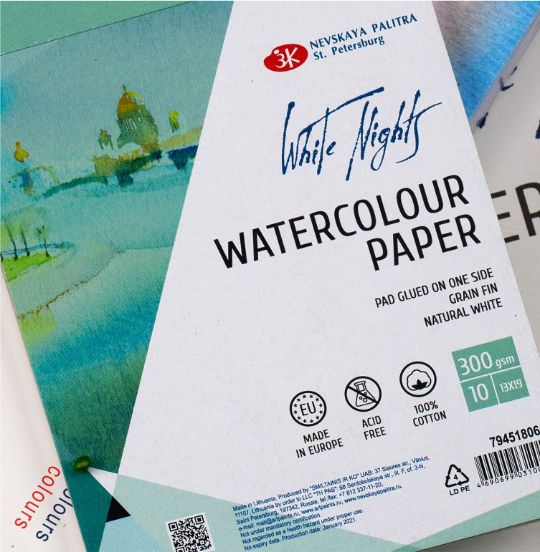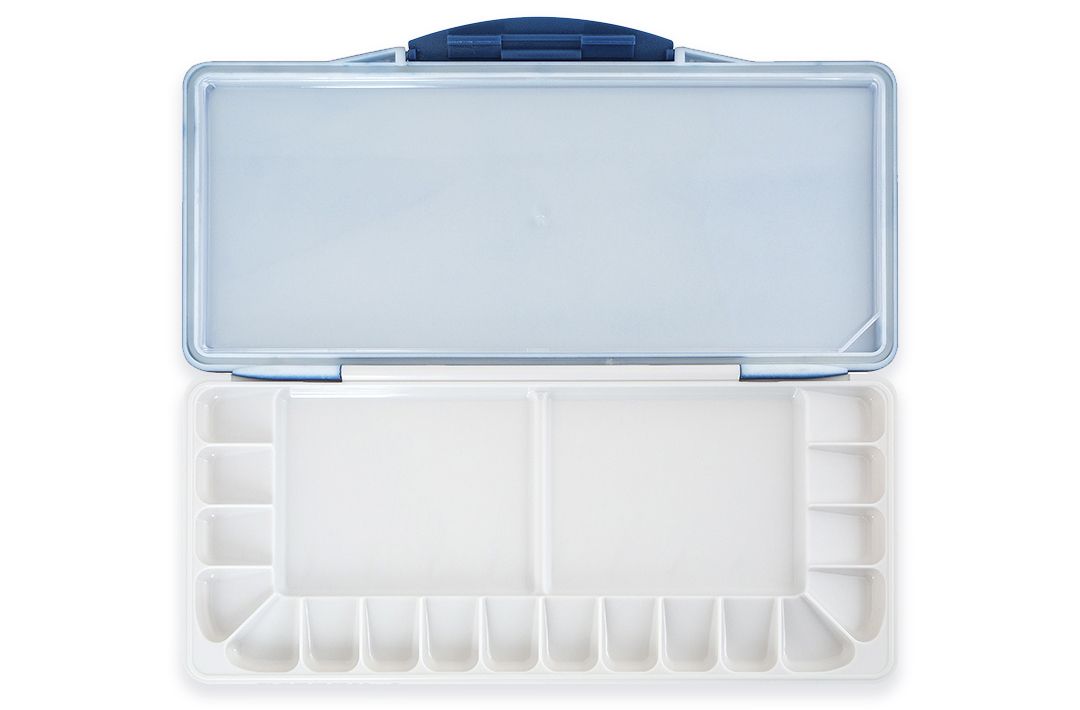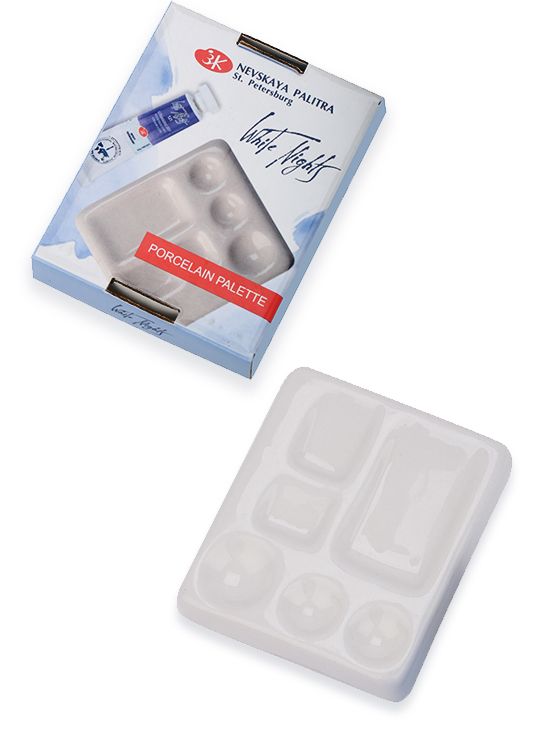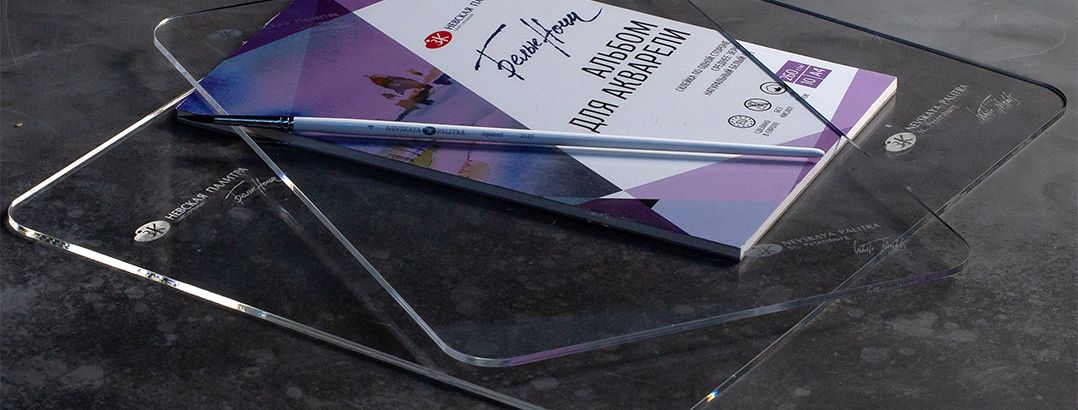WATERCOLOUR SUPPLIES
PAPER.
For quick calligraphic painting, moisture-absorbing rice paper, which can have a density of only 20 g/m2, is suitable - it instantly captures the movement of the brush. A completely different quality of painting can be achieved on paper with a density of 640 g/m2 or more, this is cardboard. Such paper does not deform from water and is perfectly suitable for plein air painting, even under scorching sunlight, it can keep moisture for enough time to work.
For sketches, paper of low density 180 and 240 g/m2 can be used.
For professional painting, paper of density 300 g/m2 is suitable.
All famous producers produce paper of three types of texture:
- Large-grained.Naturally pressed – Rough Surface / Grain Torchon
- Medium.Cold pressed – Cold pressed, CP/NOT Surface / Grain Fin
- Fine.Hot pressed – Hot pressed, HP Surface/Grain Satin.

100% Cotton
100% Cotton absorbs water and paint easily and quickly, which allows you to achieve most watercolour effects. Great for techniques with multilayering. However, since the paint is so easily absorbed, you need to take brighter colour, after drying it will pale a little.

100% Pulp
100% Pulp absorbs water worse, which allows you to paint on it in wet techniques, and maintain the initial brightness of the colour, but such type of paper is not suitable for multilayer painting. Glazing, washings and other similar techniques are excluded because the lower layer of paint, even if it is dried, will still wash off. Pulp paper is a great choice for those who paint in the alla prima technique (single-layer work).

The mixed composition
The mixed composition of the paper allows you to inherit the qualities of both types of papers: the colours look brighter, and the surface of the sheet is stronger, which allows the first layer of paint to be better fixed on the sheet and not wash off when applying the next layer. The cotton fibers in the composition allow to obtain some of the properties of cotton paper - the additional depth and the way the applied paint spreads on the surface. The paint spreads better on paper (thanks to the cotton in the composition), and the colours remain brighter (thanks to the pulp in the composition).
BRUSHES.



PALETTES.
White ceramic palettes are flat or have recesses for preparing mixtures are very convenient and pleasant to work, unlike plastic ones, completely washed from traces of paint.It is not recommended to use paper palettes, since paper absorbs water, is covered with pellets from repeated friction of the brush. In addition, glue is washed out of poor-quality paper (it is unlikely that anyone will use high-quality paper specifically for the palette) and penetrates into painting.



WATERCOLOUR BOARD.
For watercolour painting in a wet technique or in mixed techniques, such a board is also irreplaceable: a sheet of paper, richly wetted on both sides with water, has good adhesion with a board, you don't need to fix it with scotch tape. The thickness of the board depends on the size of the work, usually it is 3 mm for small and medium-sized formats and 4 mm for large formats. To preserve moisture, a thin white cotton cloth can be placed under the wet sheet of paper, which will slow down the process of evaporating moisture from the sheet.

Container with water with volume not less than 1 liter. You always need to have enough water to rinse the brush. Water must be regularly changed and you need to ensure that it does not become a paint solution itself.
WORKING PLACE OF THE WATERCOLOUR ARTIST.
The nature of watercolour painting is specified by the technological features of working with water paints, or, more precisely, the decisive role in the nature of watercolour painting belongs to water. And since water is a very mobile material, it instantly reacts to a variety of effects. Therefore, paints dissolved in water create unpredictable colour transitions in painting, and for the same reason, watercolour has the need for constant technological control over the movement of water.
The strength of the tone in watercolour is achieved by accurate and well-considered colour selection, transparency of the paints, ease of application and speed of drying with a controlled tilt of the pad. In order to avoid unpredictable colour behavior in watercolour painting and control the effects, it is important to observe the basic rules for organizing the workplace.
PRACTICAL TIPS FOR WORKPLACE ORGANIZATION:
The materials for painting should be available and convenient in any way of work (standing or sitting, in the vertical or horizontal position of the pad). Next to the artist, at a convenient distance from the hand (on the right - for right-handed, on the left - for left-handed) there should be a special table (ordinary stool, bedside table, bedside table on wheels), where a palette, brushes, a jar with water, paints and other necessary tools should be placed.
The pad with prepared paper may be placed vertically, mounted on an easel, or horizontally, mounted on a table. The main thing for the watercolour process is the mobility and stability of the working surface. You might suddenly need a different pad tilt. When working, the hand should be extended, and the back should be straight. This condition must be followed especially carefully, because proper posture is necessary to preserve health, which gives life potential and feeds creative energy.
So, with the correct position of the pad, a straight back, an extended arm, the viewing angle of the working surface will be maximum, and the visible distortions - minimal. The larger the size of the sheet with the painting, the more often you need to move away and look at it from a distance.
Before starting work, it is important to take care of the correct lighting. Scattered natural daylight suits for painting best, since it does not give distortions of colour perception. Direct sunlight interferes with work because the illuminated whiteness of the paper interferes with colour perception. It is especially diffcult to work if different illuminated areas from the shadow and light appear on the working surface. In plein air conditions, it is desirable to be located in the shade in order to ensure comfortable working conditions. Special large umbrellas are also used for this. If you work under artificial lighting, then you need to try to bring it closer in the spectrum of colour radiation to the daytime. The combination of warm and cold scattered light is considered optimal.
Despite the availability and prevalence, the watercolour technique remains mysterious and magical. With seeming ease, this material, by birth associated with water, with its disobedience and spontaneity, can resist the artist for a long time. But with the right choice of materials, compliance with simple rules, as well as constant practice, the result will not be long awaited.